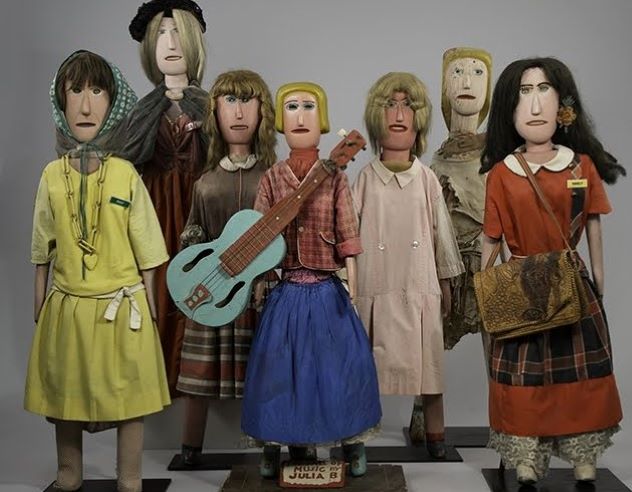 History
History  History
History  Weird Stuff
Weird Stuff 10 Everyday Products Surprisingly Made by Inmates
 Movies and TV
Movies and TV 10 Actors Dragged out of Retirement for One Key Role
 Creepy
Creepy 10 Lesser-Known Shapeshifter Legends from Around the World
 Animals
Animals 10 Amazing Animal Tales from the Ancient World
 Gaming
Gaming 10 Game Characters Everyone Hated Playing
 Books
Books 10 Famous Writers Who Were Hypocritical
 Humans
Humans 10 of the World’s Toughest Puzzles Solved in Record Time
 Mysteries
Mysteries 10 Scientific Mysteries We Don’t Fully Understand
 Weird Stuff
Weird Stuff 10 Celebrities Who Have Admitted to Alien Encounters
 History
History Ten Revealing Facts about Daily Domestic Life in the Old West
 Weird Stuff
Weird Stuff 10 Everyday Products Surprisingly Made by Inmates
 Movies and TV
Movies and TV 10 Actors Dragged out of Retirement for One Key Role
Who's Behind Listverse?

Jamie Frater
Head Editor
Jamie founded Listverse due to an insatiable desire to share fascinating, obscure, and bizarre facts. He has been a guest speaker on numerous national radio and television stations and is a five time published author.
More About Us Creepy
Creepy 10 Lesser-Known Shapeshifter Legends from Around the World
 Animals
Animals 10 Amazing Animal Tales from the Ancient World
 Gaming
Gaming 10 Game Characters Everyone Hated Playing
 Books
Books 10 Famous Writers Who Were Hypocritical
 Humans
Humans 10 of the World’s Toughest Puzzles Solved in Record Time
 Mysteries
Mysteries 10 Scientific Mysteries We Don’t Fully Understand
 Weird Stuff
Weird Stuff 10 Celebrities Who Have Admitted to Alien Encounters
Top 10 Creepiest Doll and Statue Havens
Dolls, figurines, or puppets have fascinated humans for millennia. Our minds can conjure them up into anything, just like our hands can fashion them out of anything. For some, this imaginary manifestation has become a legitimate fear. Experts refer to it as automatonophobia, which is a fear of objects possessing humanoid features.
Why they frighten us is anyone’s guess.[1] Suggestions range from evolutionary, which is our primordial instinct to recognize and react to faces, to socially reinforced through movies and media. Regardless, it’s fair to assume that dolls—without meaning to—mean a lot.
So, we’ve compiled a list of doll, sculpture, and puppet sanctuaries from around the globe that are known to send visitors’ instincts into a tailspin. Although this list is not exhaustive, it’s a creepy start. And, many of these are open to the public, so go have a look and let us know what you think.
Related: 10 Peculiar Museums You Must See To Believe
10 Island of the Dolls, Mexico

Squeezed between the channels of Xochimilco south of Mexico’s capital is a patch of farmland that has sowed its name in the ghostly legends. Known locally as Isla de las Munecas (Island of Dolls), its sprout to notoriety is disturbing and tragic. It all began in 1950 when a man named Julian Barrera left his wife and young daughter to live as a recluse on the island. While there, Julian came across the body of an unknown young girl floating in the canal. Also floating in the water was a doll that Julian assumed belonged to the girl, which he hung from a nearby tree, making sure it faced where he had found the body. Numerous versions abound of what prompted Julian to perform this peculiar ritual, but everyone agrees he never stopped.
Following the incident, he was seen obsessively scouring the canals and trash heaps for discarded dolls until his bizarre collection grew from one to hundreds. Julian hung his cherished assemblage across the island in whatever condition he’d found them in. As a result, many are visibly damaged, missing a head or limb, some without an eye or two altogether. Furthermore, due to exposure, the dolls have become more decrepit, amplifying their spine-chilling aura. Unsurprisingly, visitors to the island often report paranormal activity. Some claim if you listen closely, you can hear the dolls whisper to each other.
In 2001, Julian’s body was discovered in the canal. The official cause of death was a heart attack, although legend insists that Julian was found at the exact spot where he had found the girl’s body.[2]
9 Stare Into the History of Dummies, USA
Belly speakers! That is what the ancient Romans called ventriloquists. Like us, their ability to appear to have voices emanating from inside their stomachs fascinated them. However, unlike us, the ancients believed the voices belonged to the dead, who had taken residence in the ventriloquist’s gut to communicate with the living. Therefore, ventriloquism served to channel the world of the dead. This was their status until the rise of Christianity, when it was deemed witchcraft and outlawed. It was only during the 18th century that it evolved from its haunting origins to the comedic form we know today.
The Vent Haven Museum in Fort Mitchell, Kentucky, is the only place in the world where this turbulent history of ventriloquism is displayed. William Shakespeare Berger founded the museum in 1973, and it houses all things ventriloquist sourced from around the world. It is the permanent home for authentic dummies used by icons like Jeff Dunham, Jay Johnson, and Willie Tyler. It also has replicas of other luminaries such as Edgar Bergen, Shari Lewis, and Bozo the Clown. Puppet depictions of U.S. presidents ranging from Richard Nixon to George W. Bush also feature in the collection. The museum has around 900 dummies in total.
If having glassy eyes following you around isn’t daunting, Vent Haven has seasonal openings each year where customers can even adopt a dummy for a year for $50.[3]
8 An Abandoned Park of Statues, Japan
The Hidden Village of Statues in Japan’s Toyama prefecture is a perfect example of how a thoughtful idea can backfire eerily.
Back in 1989, Mutsuo Furukawa set out to create a serene park where people could meditate and unwind, away from the bustle of modern-day Japan. Besides trees and flowers, his park would feature life-sized busts of people. He commissioned over 800 of them in the likeness of his friends, family, and coworkers. Others depict local legends, historical figures, and Buddhist icons. Furukawa’s dream came true for a time. After he died in 2012, the park fell into disrepair and was consumed by vegetation. Then, in 2016, its rediscovery by a local photographer sparked tourist attention for reasons that are the exact opposite of what he intended.
Now run by volunteers, it has been dubbed Fureai Sekibutsu no Sato, which translates to “Village where you can meet Buddhist statues.” Locals avoid it because they believe the sculptures come to life at night. Meanwhile, thousands of visitors throng to the grounds each year. Many describe the experience as feeling like you’ve wandered into a forbidden zone. Curiously, during a full moon, the shadows cast by the statues create the impression that you are being followed. For the time being, it’s fair to say that only the statues can unwind calmly after a long day’s work in this park.[4]
7 Another Abandoned Park of Statues, Italy

In 1547, following a series of tragic incidents in his personal life that culminated in the death of his wife, Prince Pier Francesco Orsini commissioned a creation of wonder to channel his grief. The result was the Bomarzo Gardens in Italy. This woodland enclave located near Viterbo and designed by Pirro Ligorio was initially called the Sacred Grove, but later locals renamed it Monsters’ Grove. For generations, visitors have been stunned by the numerous larger-than-life sculptures that adorn these otherwise lonely woods. Among them are an elephant mauling a Roman legionnaire, a giant tearing another in half, and the showstopper—a colossal screaming head of Orcus, the deity of the underworld in Roman mythology.
The Park of the Monsters has influenced several works, most notably Salvador Dali’s The Temptation of Saint Anthony. Others, including the poet André Pieyre de Mandiargues, have written essays about it. Niki de Saint Phalle’s Tarot Garden (a serious contender for a spot on this list) was similarly inspired by the Bomarzo Garden.
After a brief period of abandonment, the sculptures re-captured the world’s attention when, in the 1950s, Salvador Dali documented a short film about the park. The result was a restoration program that converted it to the popular destination it is today.[5]
6 Spend a Night With Clowns, USA
Cursed motels, along with evil clowns and haunted graveyards, are recurring themes in horror films. So it should come as no surprise that blending this trio is not for the faint of heart. Enter Tonopah’s Clown Motel in Nevada. Nicknamed “America’s Scariest Motel,” it was built in 1985 as a memorial to Clarence David, a self-described clown enthusiast. It is home to over 2,000 clowns from around the world, intended to give you the jitters. Not to worry, owners guarantee that a few of these prospective roommates are actually “happy clowns.”
The Clown motel also sits next to the Old Tonopah Cemetery, which adds to the ambiance. Clarence, whose work inspired the motel, is buried here, as are many of the miners who perished in the Tonopah-Belmont Mine Fire disaster of 1911. Combined with the graveyard’s long-standing ghostly allegations of its own, it’s no surprise that reports of paranormal activity are rife. Among them is a once-famous local joker who continues to play pranks on the unsuspecting from beyond the grave.
We cannot vouch for the existence of “happy clowns” in case you happen to spend the night at Clown Motel; as for ghosts, their misty reputation for veracity still eludes us.[6]
5 Abandoned Dolls of Chernobyl, Ukraine

Shortly after midnight on April 26, 1986, the nuclear power plant at Chernobyl, in what was then the USSR, fried itself into the world’s worst nuclear disaster. As radioactive particles seeped into the air, Soviet authorities ordered immediate evacuations of all settlements near the facility. The town of Pripyat came under this zone, and as a result, it was closed to the public and designated a restricted area. However, it is now teeming with disaster tourists.
Following Pripyat’s hasty evacuation, a considerable chunk of it appears to have remained undisturbed, serving as a major lure for visitors. Abandoned dolls are a common sight among the rust and crumble. They’re strewn about everywhere, some sleeping on hospital beds, some in parks wearing gas masks, while others appear to be hiding in schools. Contrary to popular belief, most of these dolls aren’t lying around where they were dropped in the ensuing evacuation. Tourists have been known to move the dolls around and pose them for a perfect photograph, and some have even smuggled in their own. We hope the likes were worth it, given that visitors are advised not to touch anything within the exclusion zone.[7]
4 A Village Resurrected Back to Life, Japan
Japan’s population is shrinking fast due to low fertility rates. Particularly hard hit in the crisis are rural areas, where entire communities are abandoned in favor of the urban regions. Nagoro, a village nestled on the slopes of Mount Miune, is one such community. Once a bustling village, it has transformed into a ghost town.
Tsukimi Ayano’s return to Nagoro in the early 2000s brought her face to face with this reality. As a young woman, Ayano had moved from Nagoro to Osaka, where she worked before returning to enjoy her retirement. Instead of familiar and friendly faces, she was greeted with a sea of emptiness. It was in this void that Ayano’s vision for Nagoro’s regeneration emerged: Life-sized dolls!
Ayano’s dolls, made of straw, newspaper, and wood, are unlike any other. They are meant to represent former residents who have either moved away or died. Each doll is meticulously crafted to mimic a specific facial expression, retain their own story or personality, and are usually dressed in clothes and accessories that once belonged to the person they represent.
Ayano’s vision to repopulate Nagoro appears to have come true. The number of her new “residents” has surpassed that of humans by tenfold. Aside from that, human activity has resumed in the village as well. Construction workers carrying out maintenance, commuters crowding at a bus stop, or students waiting for class to begin, are just a few examples of people frozen in time in Nagoro.[8]
3 The Possum Trot, USA

Calvin Black met Ruby while working for a circus in Georgia, and the couple married in 1953. That same year, they relocated to Yermo, California, hoping that a climate change would be good for Calvin’s health. To make ends meet in the heart of the Mojave Desert in California, the couple opened the Possum Trot, a refreshment stop along Highway 15. Visitors to the shop were met by various handmade art forms, including small-scale windmills, stagecoaches, trains, and over 80 handcrafted, nearly life-size dolls.
Their dolls, the majority of which are female, were inspired by and named after friends and other famous women throughout history. Before crafting one, they pondered the doll’s persona, even down to the hair type, eye color, and sense of style. The dolls’ faces were made of redwood taken from electrical power poles knocked down in car accidents. The abdomen was made of sugar pine, while the other trimmings, such as wigs and garments, were salvaged from dumps. To top it all off, the dolls could interact with stunned customers via built-in speakers.
Calvin died in 1972, and before his death, he requested that his creation be burned down, but this did not happen. Possum Trot was dismantled after Ruby’s death in 1980, and most of their artforms were sold. Michael Hall, an art collector, amassed the largest surviving collection of the dolls and other original materials. He donated his collection to the Milwaukee Art Museum in 1989, where Miss Ripple, Helen Marvel, Little Red Riding Hood, and other dolls are still on display.[9]
2 Pray With Ghosts, Czech Republic
Lukova’s St. George Church has had its share of mishaps over the years. Accidents have forced it to be rebuilt multiple times since it was first constructed in the 14th century. When a piece of the roof fell during a funeral service in 1968, the locals had had enough. Believing it was cursed, the church was abandoned and left to rot.
In 2014, a caretaker took pity on the deteriorating structure and reached out to a local artist for help to bring it back to life. After some considerations, they realized that the only way to ensure St George’s bright future was to exploit its haunted past: ghosts. To create these ghostly creatures, the artist used plaster models of real people, draped them in shawls, and placed them in pews and other areas throughout the cathedral. The thirty or so ghosts are said to represent the spirits of Sudeten Germans who resided in the area before being expelled following WWII.
Naturally, news of ghosts praying silently in a haunted church spread like wildfire, attracting visitors eager to capture a photograph of a real one in action. With visitors came the funds needed to nurse St George back to life. Likewise, the locals appear to have re-embraced the church, and they eagerly join the ghosts in prayer every Sunday.[10]
As the old saying goes, prayers do get answered in the end.
1 Walk Into a Personal Diary, Finland
The Parikkala Sculpture Garden in Finland appears to be your typical sculpture collection in a family backyard. Except that this backyard is home to nearly 500 concrete sculptures, the majority of which are life-sized, the work of one person. This collection was not intended for curious visitors to gawk at; rather, it is a personal diary depicting the artist’s hopes, hobbies, and fears, all cast in stone. Human sculptures are the most common subject matter, although other subjects are also featured.
Particularly striking is a cluster of over 200 statues, supposedly self-portraits, in various yoga poses. However, it’s their sinister stares that capture attention instead of the fact that they are supposed to be a memory of his young body. They range from blank to aggressive to blatant diabolic grins. Real human teeth can be seen in some of the statues’ smirks. Others have hidden speakers that make a walk through this backyard an unsettling experience.
A bit of a recluse, Veijo Rönkkönen, was the man behind it all. Before his untimely death in 2010, he occasionally let guests into his garden, only to communicate with them via notes. Rönkkönen refused to exhibit his work, despite numerous requests, instead preferring to bury it and leave it alone in silence. Today, however, as many as 30,000 people visit his backyard annually.[11]
Oh, the human teeth were donated.








